wheel LEXUS IS300 2021 Owners Manual
[x] Cancel search | Manufacturer: LEXUS, Model Year: 2021, Model line: IS300, Model: LEXUS IS300 2021Pages: 436, PDF Size: 8.27 MB
Page 2 of 436

2TABLE OF CONTENTS
For your information ......................................5
Reading this manual ....................................... 9
How to search ............................................... 10
Pictorial index .................................................. 11
1-1. For safe use Before driving .................................... 22
For safe driving.................................. 23
Seat belts ............................................. 24
SRS airbags ....................................... 28
Front passenger occupant classifi- cation system ................................. 36
Exhaust gas precautions .............. 40
1-2. Child safety Riding with children.......................... 41
Child restraint systems ................... 41
1-3. Lexus Enform Lexus Enform Safety Connect .. 54
1-4. Theft deterrent system Engine immobilizer system ......... 60
Alarm..................................................... 62
Theft prevention labels ................. 63
2-1. Instrument cluster Warning lights and indicators .... 66
Gauges and meters ......................... 71
Multi-information display............. 76
Fuel consumption information ... 833-1. Key information
Keys ...................................................... 88
3-2. Opening, closing and locking the doors and trunk
Doors .................................................... 92
Trunk ..................................................... 96
Smart access system with push-but- ton start ............................................. 99
3-3. Adjusting the seats Front seats........................................ 106
Rear seats......................................... 107
Driving position memory ........... 108
Head restraints ................................. 111
3-4. Adjusting the steering wheel and mirrors
Steering wheel ................................. 113
Inside rear view mirror ................. 114
Outside rear view mirrors........... 116
3-5. Opening, closing the windows and moon roof
Power windows .............................. 118
Moon roof ........................................ 120
4-1. Before driving Driving the vehicle......................... 124
Cargo and luggage...................... 130
Vehicle load limits.......................... 132
Trailer towing................................... 132
Dinghy towing ................................ 133
4-2. Driving procedures Engine (ignitio n) switch ............... 134
1For safety and security
2Vehicle status information and
indicators
3Before driving
4Driving
Page 3 of 436
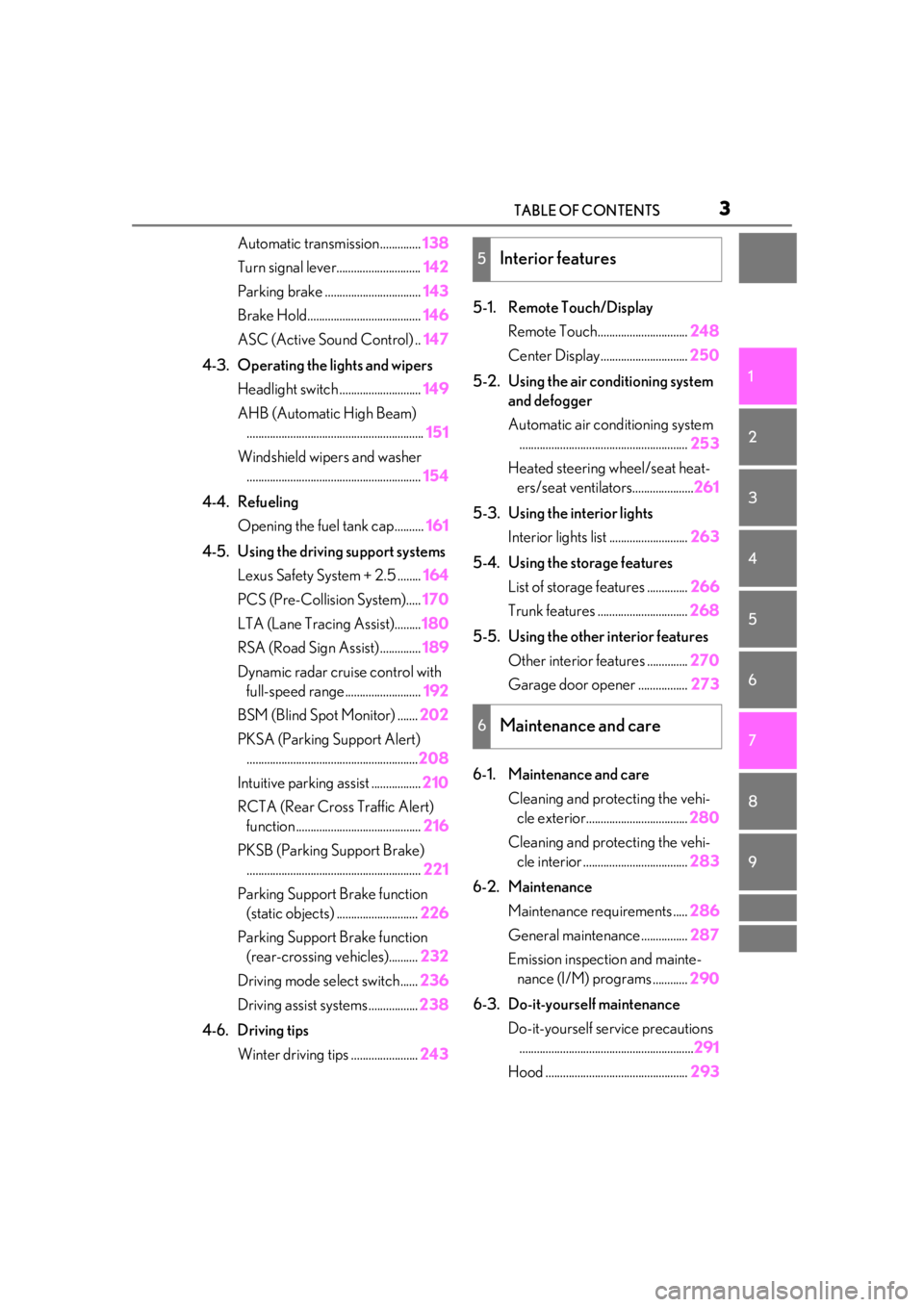
3TABLE OF CONTENTS
1
2
3
4
5
6
7
8
9
Automatic transmission..............138
Turn signal lever............................. 142
Parking brake ................................. 143
Brake Hold....................................... 146
ASC (Active Sound Control) .. 147
4-3. Operating the lights and wipers Headlight switch ............................ 149
AHB (Automatic High Beam) ............................................................. 151
Windshield wipers and washer ............................................................ 154
4-4. Refueling Opening the fuel tank cap.......... 161
4-5. Using the driving support systems Lexus Safety System + 2.5 ........ 164
PCS (Pre-Collision System)..... 170
LTA (Lane Tracing Assist)......... 180
RSA (Road Sign Assist) .............. 189
Dynamic radar crui se control with
full-speed range.......................... 192
BSM (Blind Spot Monitor) ....... 202
PKSA (Parking Support Alert) ........................................................... 208
Intuitive parking assist ................. 210
RCTA (Rear Cross Traffic Alert) function ........................................... 216
PKSB (Parking Support Brake) ............................................................ 221
Parking Support Brake function (static objects) ............................ 226
Parking Support Brake function (rear-crossing vehicles).......... 232
Driving mode select switch...... 236
Driving assist systems ................. 238
4-6. Driving tips Winter driving tips ....................... 2435-1. Remote Touch/Display
Remote Touch............................... 248
Center Display.............................. 250
5-2. Using the air conditioning system and defogger
Automatic air conditioning system.......................................................... 253
Heated steering wheel/seat heat- ers/seat ventilators..................... 261
5-3. Using the interior lights Interior lights list ........................... 263
5-4. Using the storage features List of storage features .............. 266
Trunk features ............................... 268
5-5. Using the other interior features Other interior features .............. 270
Garage door opener ................. 273
6-1. Maintenance and care Cleaning and protecting the vehi-cle exterior................................... 280
Cleaning and protecting the vehi- cle interior .................................... 283
6-2. Maintenance Maintenance re quirements .....286
General maintenance................ 287
Emission inspection and mainte- nance (I/M) program s
............290
6-3. Do-it-yourself maintenance Do-it-yourself service precautions............................................................ 291
Hood ................................................. 293
5Interior features
6Maintenance and care
Page 4 of 436

4TABLE OF CONTENTS
Positioning a floor jack...............293
Engine compartment.................. 295
Tires ................................................... 303
Tire inflation pressure .................. 312
Wheels............................................... 313
Air conditioning filter...................315
Electronic key battery ................. 316
Checking and replacing fuses ............................................................ 318
Headlight aim................................. 320
Light bulbs ........................................ 321
7-1. Essential information Emergency flashers..................... 328
If your vehicle has to be stopped in an emergency ............................. 328
If the vehicle is trapped in rising water............................................... 329
7-2. Steps to take in an emergency If your vehicle needs to be towed............................................................ 331
If you think something is wrong ........................................................... 335
Fuel pump shut off system ........ 336
If a warning light turns on or a warn- ing buzzer sounds ..................... 337
If a warning message is displayed ........................................................... 346
If you have a flat tire..................... 349
If the engine wi ll not start .......... 357
If you lose your keys .................... 358
If the fuel filler door cannot be opened........................................... 359
If the electronic key does not oper- ate properly ................................. 359If the vehicle battery is discharged
........................................................... 361
If your vehicle overheats ........... 365
If the vehicle becomes stuck ... 368
8-1. Specifications Maintenance data (fuel, oil level, etc.) ................................................. 372
Fuel information............................ 382
Tire information ............................ 384
8-2. Customization Customizable features .............. 394
8-3. Initialization Items to initialize ........................... 404
9-1. For owners Reporting safety defects for U.S. owners ........................................... 406
Seat belt instructions for Canadian owners (in French) ................... 406
SRS airbag instructions for Cana- dian owners (in French) ......... 408
Headlight aim instructions for Canadian owners (in French)............................................................ 414
What to do if... (Troubleshooting) ........................................................... 418
Alphabetical Index ........................ 421
7When trouble arises
8Vehicle specifications
9For owners
Index
Page 17 of 436
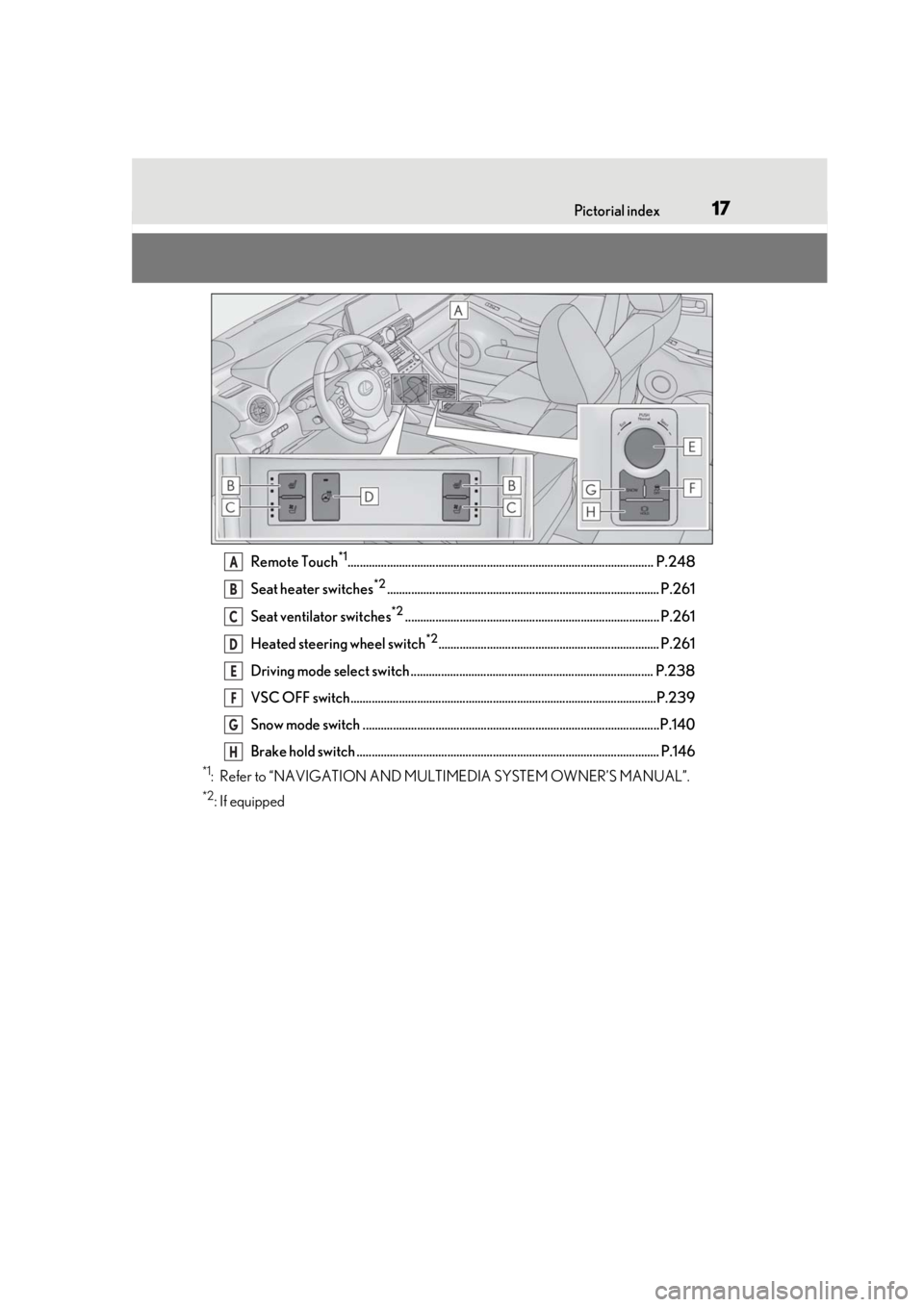
17Pictorial index
Remote Touch*1..................................................................................................... P.248
Seat heater switches
*2.......................................................................................... P.261
Seat ventilator switches
*2.................................................................................... P.261
Heated steering wheel switch
*2......................................................................... P.261
Driving mode select switch ................................................................................ P.238
VSC OFF switch.....................................................................................................P.239
Snow mode switch ..................................................................................................P.140
Brake hold switch .................................................................................................... P.146
*1: Refer to “NAVIGATION AND MULTIMEDIA SYSTEM OWNER’S MANUAL”.
*2: If equipped
A
B
C
D
E
F
G
H
Page 23 of 436

231-1. For safe use
1
For safety and security
Adjust the angle of the seatback so
that you are sitting straight up and
so that you do not have to lean for-
ward to steer. (P.106)
Adjust the seat so that you can
depress the pedals fully and so that
your arms bend slightly at the
elbow when gripping the steering
wheel. ( P.106)
Lock the head restraint in place
with the center of the head restraint
closest to the top of your ears.
( P.111)
Wear the seat belt correctly.
( P.24) Make sure that all occupants are wear-
ing their seat belts before driving the
vehicle. (
P.24)
Use a child restraint system appropri-
ate for the child until the child becomes
large enough to properly wear the
vehicle’s seat belt. ( P.41)
Make sure that you can see backward
clearly by adjusting the inside and out-
side rear view mirrors properly.
( P.114, 116)
For safe driving
For safe driving, adjust the seat and
mirror to an appropriate position
before driving.
Correct driving posture
WARNING
■For safe driving
Observe the following precautions.
Failure to do so may result in death or
serious injury.
A
B
C
D
●Do not adjust the position of the
driver’s seat while driving.
Doing so could cause the driver to lose
control of the vehicle.
●Do not place a cushion between the
driver or passenger and the seatback.
A cushion may prevent correct pos-
ture from being achieved, and reduce
the effectiveness of the seat belt and
head restraint.
●Do not place anything under the front
seats.
Objects placed under the front seats
may become jammed in the seat
tracks and stop the seat from locking in
place. This may lead to an accident
and the adjustment mechanism may
also be damaged.
●Always observe the legal speed limit
when driving on public roads.
●When driving over long distances, take
regular breaks before you start to feel
tired.
Also, if you feel tired or sleepy while
driving, do not force yourself to con-
tinue driving and take a break immedi-
ately.
Correct use of the seat belts
Adjusting the mirrors
Page 30 of 436

301-1. For safe use
Your vehicle is equipped with ADVANCED AIRBAGS designed based on the US
motor vehicle safety standards (FMVSS208). The airbag sensor assembly (ECU)
controls airbag deployment based on information obtained from the sensors etc.
shown in the system components diagram above. This information includes crash
severity and occupant information. As the airbags deploy, a chemical reaction in
the inflators quickly fills the airbags with no n-toxic gas to help restrain the motion of
the occupants.
■If the SRS airbags deploy (inflate)
●Slight abrasions, burns, bruising etc., may
be sustained from SRS airbags, due to the
extremely high speed deployment (infla-
tion) by hot gases.
●A loud noise and white powder will be
emitted.
●Parts of the airbag module (steering
wheel hub, airbag cover and inflator) as
well as the seats, parts of the front and
rear pillars, and roof side rails may be hot
for several minutes. The airbag itself may
also be hot.
●The windshield may crack.
●All of the doors will be unlocked.
( P.93)
●The brakes and stop lights will be con-
trolled automatically. ( P.239)
●The interior lights will turn on automati-
cally. ( P.264)
●The emergency flashers will turn on auto-
matically. ( P.328)
●Fuel supply to the engine will be stopped.
( P.336)
●For Lexus Enform Safety Connect sub-
scribers, if any of the following situations
occur, the system is designed to send an
emergency call to the response center,
notifying them of the vehicle’s location
(without needing to push the “SOS” but-
ton) and an agent will attempt to speak
with the occupants to ascertain the level
of emergency and assi stance required. If
the occupants are unable to communi-
cate, the agent automatically treats the
call as an emergency and helps to dis-
patch the necessary emergency services.
( P.54)
• An SRS airbag is deployed. • A seat belt pretensioner is activated.
• The vehicle is involved in a severe
rear-end collision.
■SRS airbag deployment conditions (SRS
front airbags)
●The SRS front airbags will deploy in the
event of an impact that exceeds the set
threshold level (the level of force corre-
sponding to an approximately 12 - 18
mph [20 - 30 km/h] frontal collision with
a fixed wall that does not move or
deform).
However, this threshol d velocity will be
considerably higher in the following situa-
tions:
• If the vehicle strikes an object, such as a parked vehicle or sign pole, which can
move or deform on impact
• If the vehicle is involved in an underride collision, such as a collision in which the
front of the vehicle “underrides”, or goes
under, the bed of a truck
●Depending on the type of collision, it is
possible that only the seat belt preten-
sioners will activate.
●The SRS front airbags for the front pas-
senger will not activate if there is no pas-
senger sitting in the front passenger seat.
However, the SRS front airbags for the
front passenger may deploy if luggage is
put in the seat, even if the seat is unoccu-
pied.
■SRS airbag deployment conditions (SRS
side and curtain shield airbags)
●The SRS side and curtain shield airbags
will deploy in the event of an impact that
exceeds the set threshold level (the level
of force corresponding to the impact
force produced by an approximately
3300 lb. [1500 kg] vehicle colliding with
Page 32 of 436
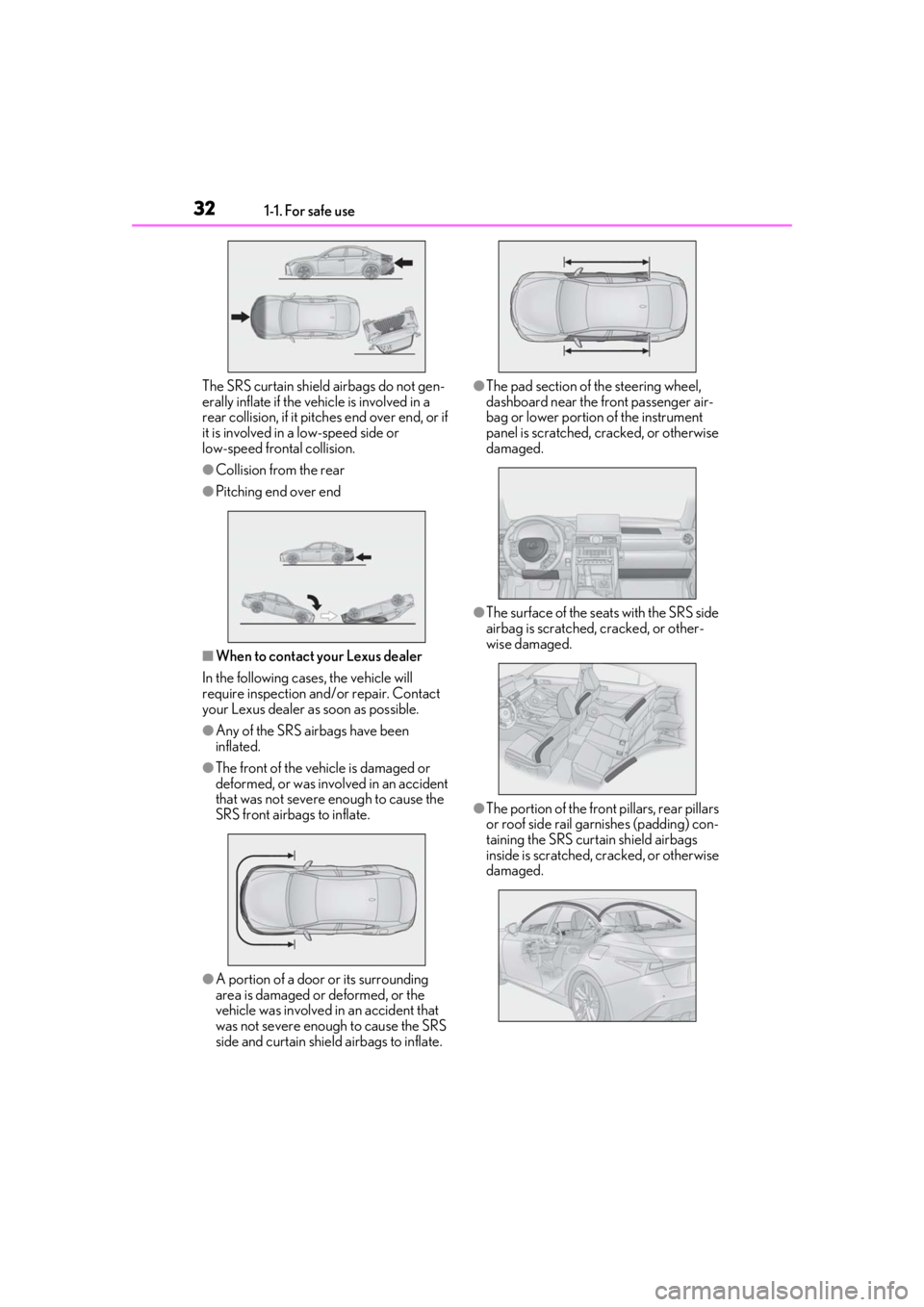
321-1. For safe use
The SRS curtain shield airbags do not gen-
erally inflate if the vehicle is involved in a
rear collision, if it pitches end over end, or if
it is involved in a low-speed side or
low-speed frontal collision.
●Collision from the rear
●Pitching end over end
■When to contact your Lexus dealer
In the following cases, the vehicle will
require inspection and/or repair. Contact
your Lexus dealer as soon as possible.
●Any of the SRS airbags have been
inflated.
●The front of the vehicle is damaged or
deformed, or was involved in an accident
that was not severe enough to cause the
SRS front airbags to inflate.
●A portion of a door or its surrounding
area is damaged or deformed, or the
vehicle was involved in an accident that
was not severe enough to cause the SRS
side and curtain shield airbags to inflate.
●The pad section of the steering wheel,
dashboard near the front passenger air-
bag or lower portion of the instrument
panel is scratched, cracked, or otherwise
damaged.
●The surface of the seats with the SRS side
airbag is scratched, cracked, or other-
wise damaged.
●The portion of the front pillars, rear pillars
or roof side rail ga rnishes (padding) con-
taining the SRS curtain shield airbags
inside is scratched, cracked, or otherwise
damaged.
Page 33 of 436
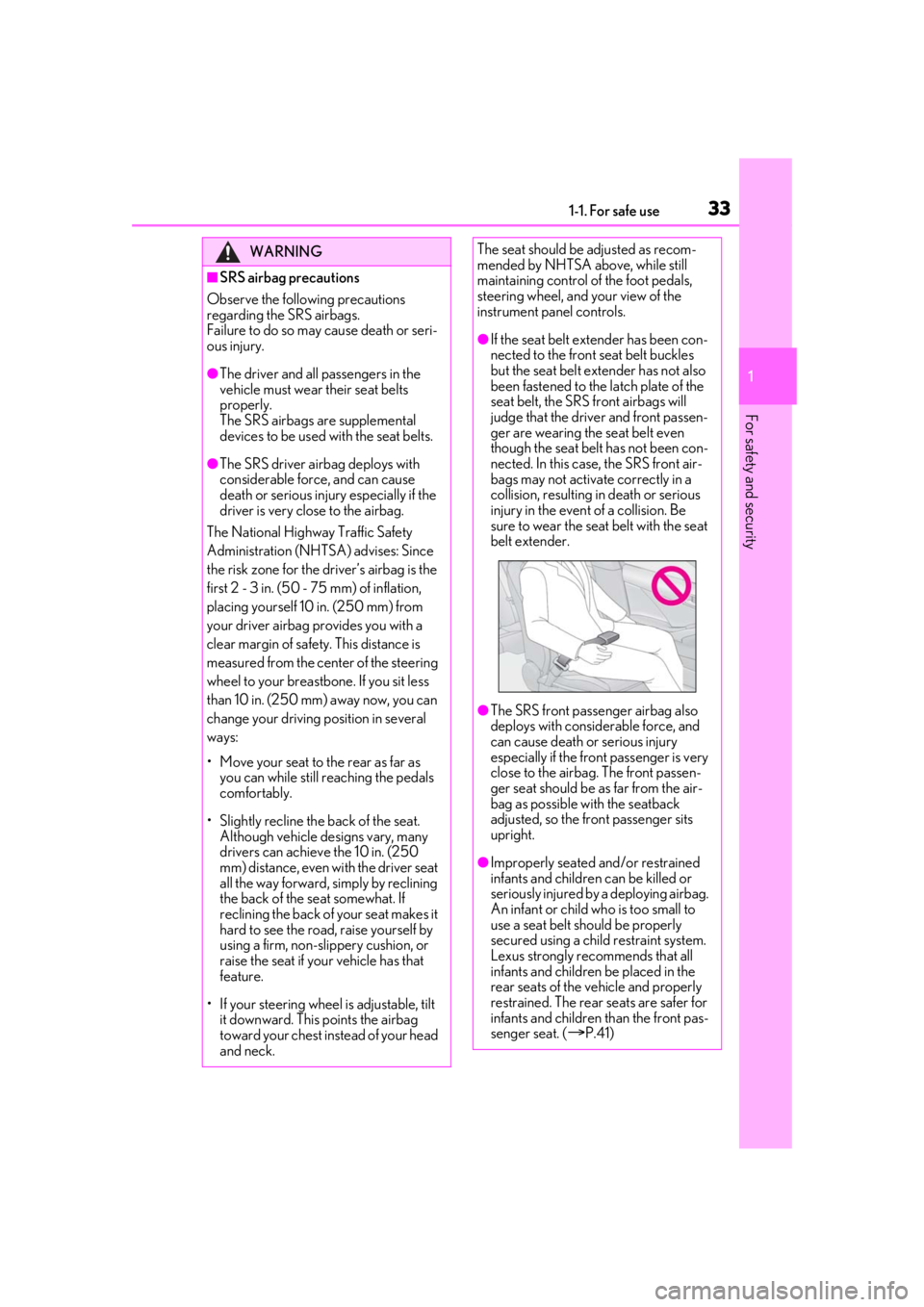
331-1. For safe use
1
For safety and security
WARNING
■SRS airbag precautions
Observe the following precautions
regarding the SRS airbags.
Failure to do so may cause death or seri-
ous injury.
●The driver and all passengers in the
vehicle must wear their seat belts
properly.
The SRS airbags are supplemental
devices to be used with the seat belts.
●The SRS driver airbag deploys with
considerable force, and can cause
death or serious injury especially if the
driver is very close to the airbag.
The National Highway Traffic Safety
Administration (NHT SA) advises: Since
the risk zone for the driver’s airbag is the
first 2 - 3 in. (50 - 75 mm) of inflation,
placing yourself 10 in. (250 mm) from
your driver airbag provides you with a
clear margin of safety. This distance is
measured from the center of the steering
wheel to your breastbone. If you sit less
than 10 in. (250 mm) away now, you can
change your driving position in several
ways:
• Move your seat to the rear as far as you can while still reaching the pedals
comfortably.
• Slightly recline the back of the seat. Although vehicle designs vary, many
drivers can achieve the 10 in. (250
mm) distance, even with the driver seat
all the way forward, simply by reclining
the back of the se at somewhat. If
reclining the back of your seat makes it
hard to see the road, raise yourself by
using a firm, non-slippery cushion, or
raise the seat if your vehicle has that
feature.
• If your steering wheel is adjustable, tilt it downward. This points the airbag
toward your chest instead of your head
and neck.
The seat should be adjusted as recom-
mended by NHTSA above, while still
maintaining control of the foot pedals,
steering wheel, and your view of the
instrument panel controls.
●If the seat belt extender has been con-
nected to the front seat belt buckles
but the seat belt extender has not also
been fastened to the latch plate of the
seat belt, the SRS front airbags will
judge that the driver and front passen-
ger are wearing the seat belt even
though the seat belt has not been con-
nected. In this case, the SRS front air-
bags may not activate correctly in a
collision, resulting in death or serious
injury in the event of a collision. Be
sure to wear the seat belt with the seat
belt extender.
●The SRS front passenger airbag also
deploys with considerable force, and
can cause death or serious injury
especially if the front passenger is very
close to the airbag. The front passen-
ger seat should be as far from the air-
bag as possible with the seatback
adjusted, so the front passenger sits
upright.
●Improperly seated and/or restrained
infants and children can be killed or
seriously injured by a deploying airbag.
An infant or child who is too small to
use a seat belt should be properly
secured using a child restraint system.
Lexus strongly recommends that all
infants and children be placed in the
rear seats of the vehicle and properly
restrained. The rear seats are safer for
infants and children than the front pas-
senger seat. (
P.41)
Page 34 of 436
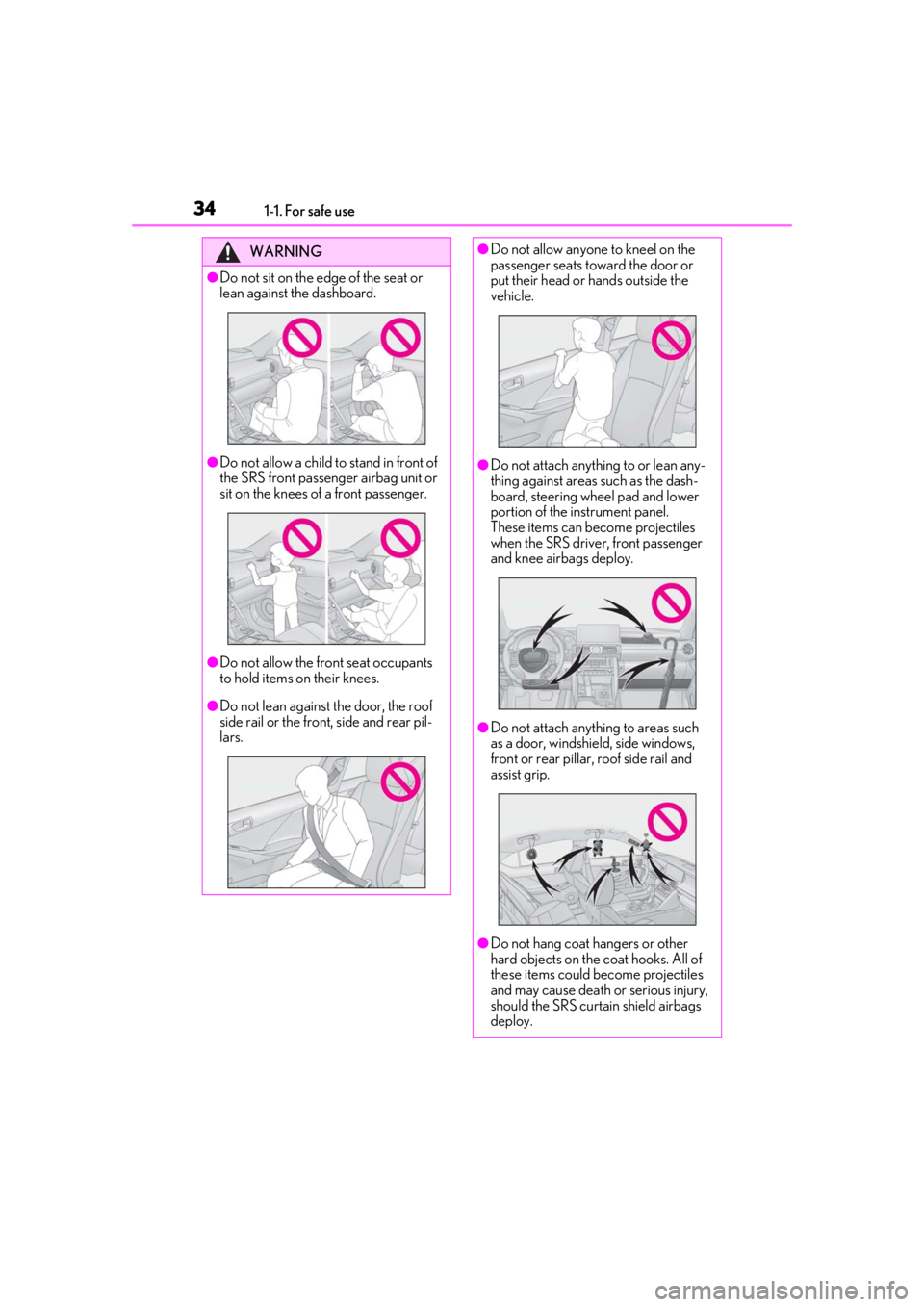
341-1. For safe use
WARNING
●Do not sit on the edge of the seat or
lean against the dashboard.
●Do not allow a child to stand in front of
the SRS front passenger airbag unit or
sit on the knees of a front passenger.
●Do not allow the front seat occupants
to hold items on their knees.
●Do not lean against the door, the roof
side rail or the front, side and rear pil-
lars.
●Do not allow anyone to kneel on the
passenger seats toward the door or
put their head or hands outside the
vehicle.
●Do not attach anything to or lean any-
thing against areas such as the dash-
board, steering wheel pad and lower
portion of the instrument panel.
These items can become projectiles
when the SRS driver, front passenger
and knee airbags deploy.
●Do not attach anything to areas such
as a door, windshie ld, side windows,
front or rear pillar, roof side rail and
assist grip.
●Do not hang coat hangers or other
hard objects on the coat hooks. All of
these items could become projectiles
and may cause death or serious injury,
should the SRS curtain shield airbags
deploy.
Page 35 of 436

351-1. For safe use
1
For safety and security
WARNING
●If a vinyl cover is put on the area where
the SRS knee airbag will deploy, be
sure to remove it.
●Do not use seat accessories which
cover the parts where the SRS side air-
bags inflate as they may interfere with
inflation of the SRS airbags. Such
accessories may prevent the side air-
bags from activating correctly, disable
the system or cause the side airbags to
inflate accidentally, resulting in death
or serious injury.
●Do not strike or apply significant levels
of force to the area of the SRS airbag
components. Doing so can cause the
SRS airbags to malfunction.
●Do not touch any of the component
parts immediately after the SRS air-
bags have deployed (inflated) as they
may be hot.
●If breathing becomes difficult after the
SRS airbags have deployed, open a
door or window to allow fresh air in, or
leave the vehicle if it is safe to do so.
Wash off any residue as soon as possi-
ble to prevent skin irritation.
●If the areas where the SRS airbags are
stored, such as the steering wheel pad
and front and rear pillar garnishes are
damaged or cracked, have them
replaced by your Lexus dealer.
●Do not place anything, such as a cush-
ion, on the front passenger’s seat.
Doing so will disperse the passenger’s
weight, which prevents the sensor
from detecting the passenger’s weight
properly. As a result, the SRS front air-
bags for the front passenger may not
deploy in the event of a collision.
■Modification and disposal of SRS air-
bag system components
Do not dispose of your vehicle or per-
form any of the following modifications
without consulting your Lexus dealer.
The SRS airbags may malfunction or
deploy (inflate) accidentally, causing
death or serious injury.
●Installation, remova l, disassembly and
repair of the SRS airbags
●Repairs, modifications, removal or
replacement of the steering wheel,
instrument panel, dashboard, seats or
seat upholstery, front, side and rear pil-
lars or roof side rails
●Repairs or modifications of the front
fender, front bumper, or side of the
occupant compartment
●Installation of a grille guard (bull bars,
kangaroo bar, etc. ), snow plows,
winches or roof luggage carrier
●Modifications to the vehicle’s suspen-
sion system
●Installation of elec tronic devices such
as mobile two-way radios and CD
players
●Modifications to your vehicle for a per-
son with a physical disability